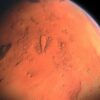Martian sunsets are uniquely moody, but NASA’s Curiosity rover captured one last month that stands out. As the sun descended over the horizon on Feb. 2, rays of light illuminated a bank of clouds. These “sun rays” are also known as crepuscular rays, from the Latin word for “twilight.” It was the first time sun rays have been so clearly viewed on Mars.
Curiosity captured the scene during the rover’s newest twilight cloud survey, which builds on its 2021 observations of noctilucent, or night-shining, clouds. While most Martian clouds hover no more than 37 miles (60 kilometers) above the ground and are composed of water ice, the clouds in the latest images appear to be at a higher altitude, where it’s especially cold. That suggests these clouds are made of carbon dioxide ice, or dry ice.
As on Earth, clouds provide scientists with complex but crucial information for understanding the weather. By looking at when and where clouds form, scientists can learn more about the Martian atmosphere’s composition and temperatures, and the winds within it.
The 2021 cloud survey included more imaging by Curiosity’s black-and-white navigation cameras, providing a detailed look at a cloud’s structure as it moves. But the recent survey, which began in January and will wrap up in mid-March, relies more often on the rover’s color Mast Camera, or Mastcam, which helps scientists see how cloud particles grow over time.

This feather-shaped iridescent cloud was captured just after sunset on Jan. 27, 2023, the 3,724th Martian day, or sol, of Curiosity’s mission. Studying the colors in iridescent clouds tells scientists something about particle size within the clouds and how they grow over time. © NASA/JPL-Caltech/MSSS
In addition to the image of sun rays, Curiosity captured a set of colorful clouds shaped like a feather on Jan. 27. When illuminated by sunlight, certain types of clouds can create a rainbowlike display called iridescence.
“Where we see iridescence, it means a cloud’s particle sizes are identical to their neighbors in each part of the cloud,” said Mark Lemmon, an atmospheric scientist with the Space Science Institute in Boulder, Colorado. “By looking at color transitions, we’re seeing particle size changing across the cloud. That tells us about the way the cloud is evolving and how its particles are changing size over time.”
Curiosity captured both the sun rays and iridescent clouds as panoramas, each of which was stitched together from 28 images sent to Earth. The images have been processed to emphasize the highlights.
Provided by
Jet Propulsion Laboratory
Citation:
NASA’s Curiosity views first ‘sun rays’ on Mars (2023, March 6)



